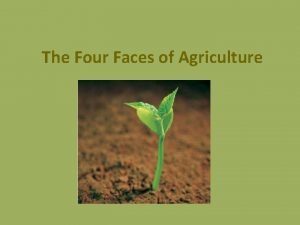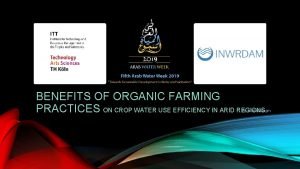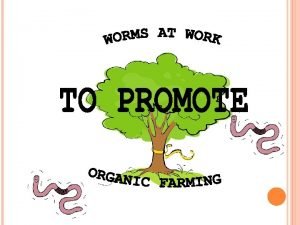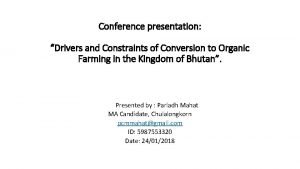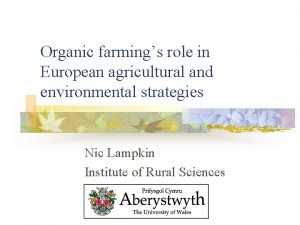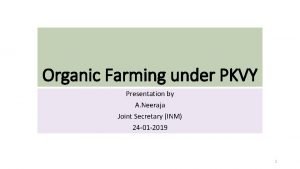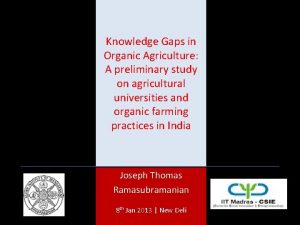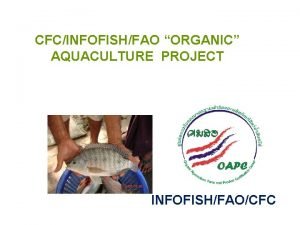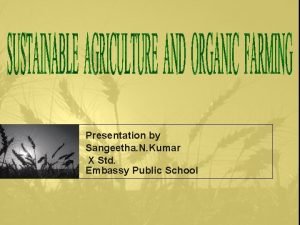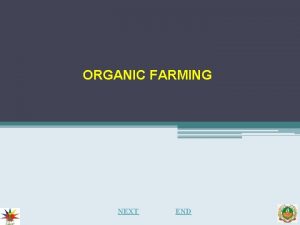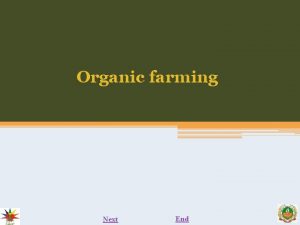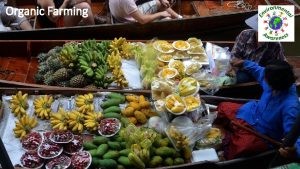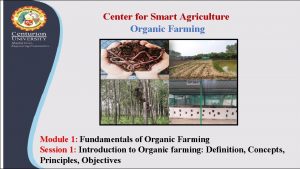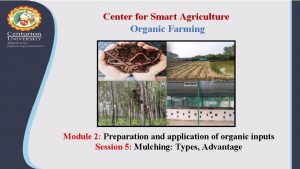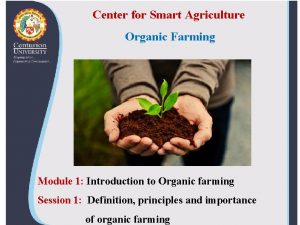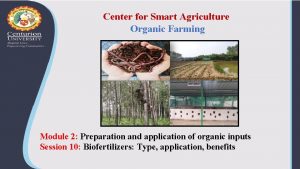Center for Smart Agriculture Organic Farming Module 3









- Slides: 9

Center for Smart Agriculture Organic Farming Module 3: Organic crop management Session 14: Crop health management in organic production

SOIL-BORNE DISEASES: § In organic agriculture most soil-borne diseases and pests can be controlled by stimulating bio-diversity in and above the soil, by feeding soil life with organic soil amendments and good soil management and by choosing site-specific crops in a balanced rotation. § The power of disease suppressive ability of (organic) soils and soil life is known, more research is needed to be able to use soil life as a management tool to increase the power of soil defence in a more controlled way. § Success is intimately related to the choice of the right crops in right sequence and in the right frequency suppressing not only populations of soil borne pests and diseases, but also of weeds and creating a diverse soil life where beneficial organism also flourish.

AIR-BORNE DISEASES In organic or reduced-input farms, root diseases and pests are, generally, less severe than or just as severe as some specific foliar diseases. Foliar diseases are more difficult to control by biological or cultural measures than root diseases, because foliar disease development is much more determined by climatic factors than by antagonistic or parasitic interactions on the Leaf surface Many foliar diseases and pests are air-borne, so that rotation (diversification in time) plays a limited role, although spatial crop diversification in combination with varietal disease resistances has an effect The concept is that for most air-borne diseases good crop management will improve the tolerance of a crop. Shortage as well as an overdose of nutrients reduces the tolerance of the crop.

Another diversification strategy to reduce spreading of airborne diseases, such as rusts and powdery mildew in cereals and pests, is through mixed cropping and variety mixtures, creating more withinfield genetic variation Other diversification practices for enlarging the self-regulatory ability of the farm-ecosystem related to crop health include biological control using natural predators. Another aspect that has received a lot of attention recently is the mycotoxins produced by Fusarium sp on cereal grain. It appears that this problem is not larger in organic agriculture than it is for conventional cereal production

SEED-BORNE DISEASES § Healthy seed is one of the most important input for crop production § Seeds free from seed borne diseases should be sown § Care should be taken to evaluate seed health before sowing

Indigenous Technical Knowledge (ITK) related to insect-pest and disease management For generations, using neem leaves in storage bags as a means of preventing damage by pests has been employed by farmers in India. It is observed that farmers of West Bengal, Bihar, Andhra Pradesh and Tamil Nadu used it to protect paddy, and those in Madhya Pradesh, Uttar Pradesh, Haryana, Punjab and Maharashtra to protect wheat. The bins, baskets or cans used for storing the grains are generally made of thatch bamboo, wood or thin sheets of aluminium. Grain is also stored in large earthenware pots, and many of the farmers in the low- income group make use of bamboo baskets, or gunnysacks (bags made of jute fibres). For every 50 kg of grains, about 200 grams of neem leaves, together with a few of the more tender branches, are added. This technique can also be used for other types of grain elsewhere in other parts of the world.

Dry mahua flowers (Madhuka india) are applied to the field at the rate of 10 -15 kg/hectare without any other mixture to control Gaygwalan (Scalopendra spp) pest that causes economic losses to crop amounting to 20 percent of soyabean. The insect, after feeding on the flower, becomes unconscious for 20 -25 days, which is enough to save the crop. Farmers collect 1000 -1200 fresh leaves with buds from Ipomea bushes. The leaves are placed in 30 -35 liters of water and boiled until the liquid turns milky white. The solution has to be sprayed within four days of its preparation to control the larvae of Helicoverpa armigera, spotted bollworm and armyworm.

Deep ploughing is taken up in summer in drylands for avoiding hard pan in soil, improving water holding capacity and pest control. Neem leaves are buried in soil for termite control. Intercropping castor, Bhendi and Cluster beans with Cotton reduced pest and disease incidence in Cotton. Farmers grow gram with linseed or coriander to save gram crop from wilt disease. Mix cropping of pigeon pea with grain sorghum escapes wilt disease. Tying the broad basal stem of mango tree with polythene, mealy bug of mango can be controlled.

Thank You
